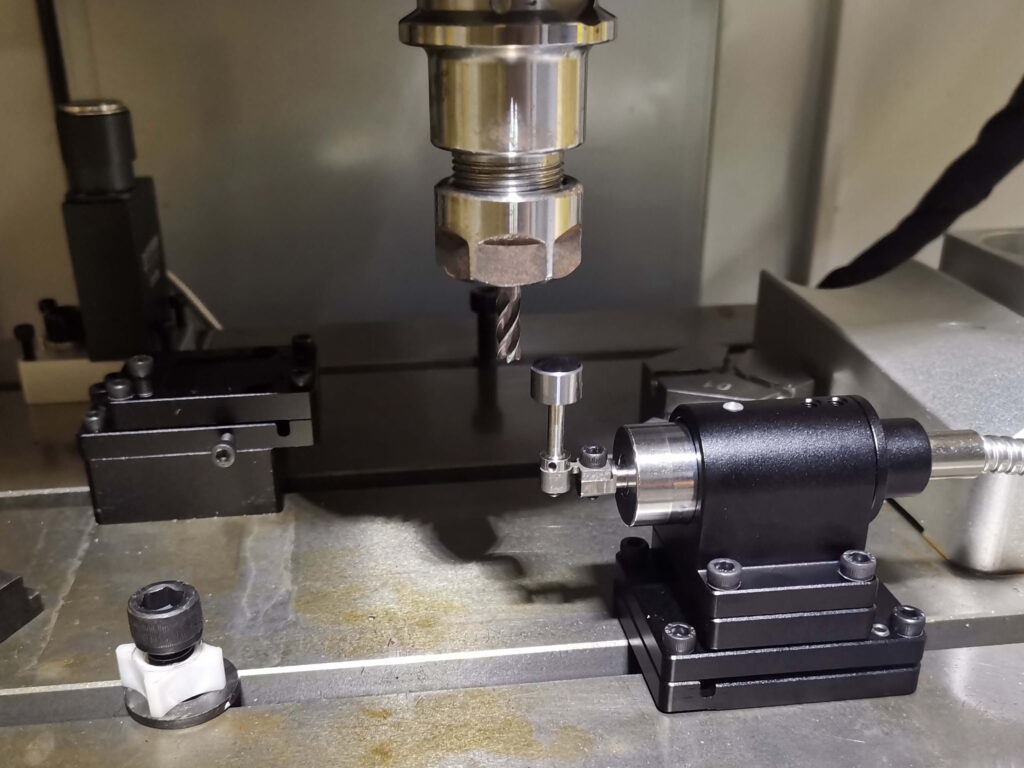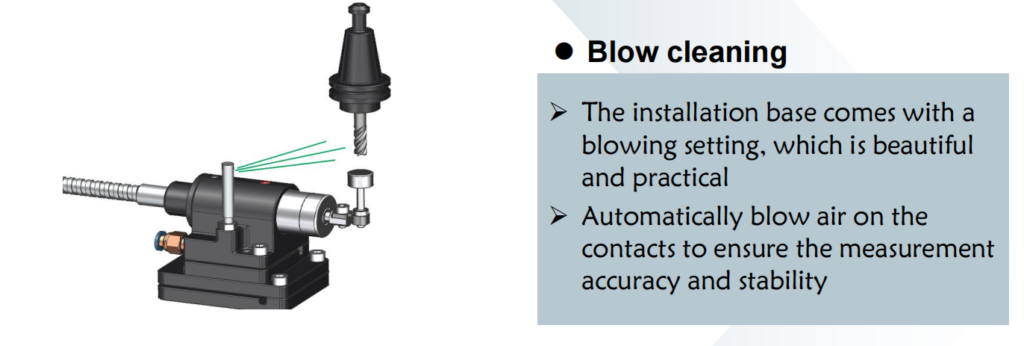Email: [email protected] Phone: (+86) 134 1323 8643
In the world of manufacturing, precision is paramount. A single millimeter off on a cut can result in a defective part, wasted materials, and delays in production. This is where tool setters come in – these ingenious devices play a crucial role in ensuring the accuracy and efficiency of CNC machining operations.
What is a Tool Setter?
A tool setter is a specialized device used in CNC machines to automatically and precisely determine the length, diameter, and sometimes even the wear and tear of cutting tools. This information is then used by the CNC controller to adjust the tool path and machine movements, guaranteeing that the tools are positioned correctly relative to the workpiece.
Importance of Tool Setters in Manufacturing
Traditionally, tool setting was a manual process involving setting gauges and manually measuring tools with calipers. This approach was not only time-consuming but also prone to human error. Tool setters revolutionized this process by offering several key advantages:
- Enhanced Accuracy:By automating tool setting, tool setters eliminate the possibility of human error during measurements, leading to significantly higher machining accuracy.
- Increased Efficiency:Automating tool setting reduces setup times and allows for faster tool changes, resulting in increased production throughput.
- Reduced Costs:Improved accuracy minimizes scrap rates and rework, leading to significant cost savings.
- Improved Tool Life:By detecting tool wear and breakage early on, tool setters help prevent tool failures and extend tool life.
- Unmanned Operation:Tool setters enable unattended or lights-out machining, where the machine can operate autonomously during non-working hours.
Working Principle of Tool Setters
Definition and Function of a Tool Setter
At its core, a tool setter is a sensor mounted on the CNC machine’s tool changer arm. This sensor, typically a probe with a spring-loaded tip, comes into contact with a reference point on the setter body. The CNC controller measures the travel distance of the probe when it touches the reference point. This travel distance, along with pre-programmed tool data like diameter and offset values, allows the controller to calculate the exact position of the tool tip.
Types of Tool Setters
There are two main types of tool setters:
- Contact Tool Setters:These are the most common type and use a physical probe to touch the reference point. They are further categorized into:
- Touch-off Tool Setters:The probe descends until it touches the reference point and triggers a signal.
- Touch Trigger Tool Setters:The probe applies a small force to the reference point before triggering a signal, ensuring consistent and reliable measurements.
- Non-Contact Tool Setters:These utilize technologies like lasers or vision systems to measure the tool tip position without physical contact. This is advantageous for delicate tools or situations where contact might damage the tool.
Benefits of Using Tool Setters
The benefits of using tool setters are numerous and have a significant impact on the overall manufacturing process:
- Improved Part Quality:Precise tool positioning leads to consistent and high-quality parts with minimal dimensional variations.
- Reduced Setup Times:Automated tool setting allows for faster tool changes and quicker machine startups.
- Minimized Scrap Rates:Accurate tool setting reduces the risk of tool breakage and machining errors, minimizing scrap and rework.
- Lower Production Costs:By optimizing machine uptime and reducing scrap, tool setters contribute to significant cost savings.
- Improved Operator Safety:Tool setters minimize the need for manual tool setting procedures, reducing the risk of operator injuries.
How Tool Setters Work
The working process of a tool setter can be broken down into three main stages:
Setting up a Tool Setter
- Installation:The tool setter is mounted on the CNC machine’s tool changer arm according to the manufacturer’s instructions.
- Calibration:The setter body with the reference point is positioned at a specific location within the machine’s work envelope. This location is then programmed into the CNC controller.
Calibration Process
- Reference Point Setting:The setter body with the reference point is positioned at the dedicated location within the machine’s work envelope.
- Data Input:The known dimensions of the reference point (e.g., diameter of a ball) are entered into the CNC controller.
- Calibration Cycle:The CNC controller executes a calibration cycle where the tool setter probe touches the reference point multiple times. The controller then calculates and stores the offset value between the probe tip and the machine’s reference point.
Monitoring and Maintenance of Tool Setters
- Regular Cleaning:The probe tip and reference surface should be cleaned periodically to remove dust, swarf, and coolant buildup that could affect measurement accuracy.
- Periodic Calibration:Depending on usage and the manufacturer’s recommendations,
Applications of Tool Setters
Tool setters have become indispensable tools in various manufacturing applications, particularly in CNC machining. Their ability to ensure precise tool positioning has revolutionized the way parts are produced, leading to significant improvements in quality, efficiency, and cost-effectiveness.
Tool Setting in CNC Machines
CNC machines rely heavily on tool setters for accurate and efficient operation. The setter’s ability to quickly and precisely determine tool length, diameter, and wear enables the CNC controller to make real-time adjustments to the tool path and machine movements. This ensures that the tools are positioned correctly relative to the workpiece, resulting in high-quality parts with minimal dimensional variations.
Precision Engineering Applications
Precision engineering, where tight tolerances and intricate details are paramount, heavily relies on tool setters. The setter’s ability to accurately measure tool dimensions and detect wear is crucial for maintaining the precision required in these applications. Tool setters are used in various precision engineering fields, including:
- Aerospace:Manufacturing aircraft components that demand extreme precision and reliability.
- Medical Device Manufacturing:Producing delicate medical implants and surgical tools that require high accuracy.
- Electronics:Fabricating precision electronic components with intricate geometries and tight tolerances.
- Automotive:Manufacturing high-performance engine parts and other critical automotive components.
Impact on Efficiency and Productivity in Manufacturing
The impact of tool setters on manufacturing efficiency and productivity is undeniable. Their ability to automate tool setting, reduce setup times, minimize scrap rates, and extend tool life has led to significant improvements in overall production output.
- Reduced Setup Times:Automated tool setting eliminates the need for manual tool measurements, significantly reducing setup times and allowing for faster machine startups.
- Minimized Scrap Rates:Accurate tool positioning and wear detection reduce the risk of tool breakage and machining errors, minimizing scrap and rework, saving time and resources.
- Extended Tool Life:By detecting tool wear early on, tool setters help prevent tool failures, extending tool life and reducing tool replacement costs.
- Unmanned Operation:Tool setters enable unattended or lights-out machining, where the machine can operate autonomously during non-working hours, maximizing machine utilization and production capacity.
People Also Ask about Tool Setters
- How does a tool setter differ from a tool probe?
A tool setter is a specialized device specifically designed for accurate tool measurement and offset determination, while a tool probe is a more general-purpose sensor that can be used for various tasks, including tool setting, part inspection, and collision detection.
- Can tool setters be used in different types of machining operations?
Yes, tool setters can be used in various machining operations, including milling, turning, drilling, and grinding. The specific type of tool setter and its capabilities may vary depending on the machining application and the requirements of the CNC machine.
- What are the best practices for maximizing the performance of a tool setter?
- Regular cleaning:Maintain the cleanliness of the probe tip and reference surface to ensure accurate measurements.
- Periodic calibration:Calibrate the tool setter regularly according to the manufacturer’s recommendations to maintain its accuracy.
- Proper tool handling:Handle tools carefully to minimize damage that could affect their dimensions and measurement accuracy.
- Monitor tool wear:Use the tool setter’s wear detection capabilities to monitor tool wear and replace tools before they fail.
- Follow manufacturer’s instructions:Adhere to the manufacturer’s guidelines for installation, calibration, maintenance, and operation of the tool setter.
Conclusion
Tool setters have revolutionized the world of CNC machining, transforming it into a more precise, efficient, and productive process. Their ability to accurately measure tool dimensions, detect tool wear, and automate tool setting has led to significant improvements in part quality, reduced scrap rates, extended tool life, and increased machine utilization. As manufacturing continues to evolve, tool setters will remain indispensable tools for achieving the highest levels of precision, efficiency, and cost-effectiveness.
Katrina
Mechanical Sales Engineer with 10+ years of experience in the manufacturing industry.Skilled in developing and executing sales strategies, building relationships with customers, and closing deals. Proficient in a variety of sales and marketing tools, including CRM software, lead generation tools, and social media. I'm able to work independently and as part of a team to meet sales goals and objectives. Dedicated to continuous improvement and learning new sales techniques.


